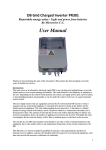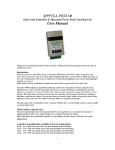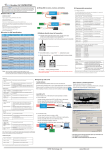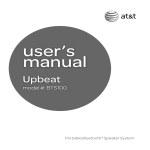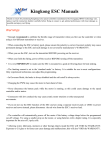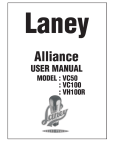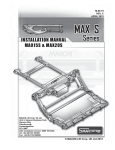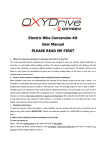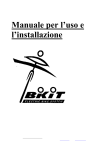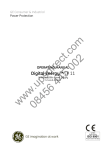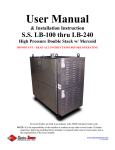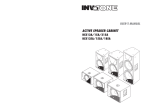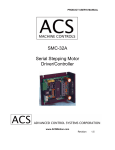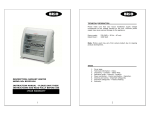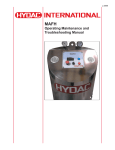Download User Manual
Transcript
Off Grid Solar Charged Inverter PR293 Renewable energy series - Light and power from the sun By: Net Comm Solar User Manual Components Front USB Port 12V Output LED Status On/Off Switch Rear 3 Pin Socket 230V Output 230V Input Inverter control Switch PV Input Socket 12V Input Battery cables Introduction Thank you for purchasing this Off Grid Charge Inverter. It uses the latest technology using a microprocessor controller to charge and monitor the battery and load. It uses a number of proprietary algorithms, to get the fastest maximum efficiency from the panel (MPPT) to charge the battery without overloading the battery, and to do battery monitoring and display the battery status. A real time LED display indicates the battery status and other functions. The Model number, serial number (if applicable), battery charge current and PV size are located on the rear of the unit. Under no circumstances must you use the charge current or PV panel other than what is on the label, as damage to the unit and or battery may arise, and will void any warranty. Before using the equipment, ensure that you connect the battery first, then the mains, then the solar panel. In accordance with our policy of continual improvement, Microsolve C.C. reserve the right to alter specifications, materials and dimensions without prior notice. E&OE. Unpacking When you purchase the unit, the battery and solar panel are not provided in the same box, and must be purchased separately. In some cases, the supplier may have sold a bundle which may include the battery and solar panel. The following is a list of the components that come together in the Off Grid Charge Inverter. Off Grid Charge Inverter control unit 10 amp Mains cable with a 16A 3 Pin plug and an IEC socket 5 meter - 2 core cable, with a 2 pin screw socket on one side and with a PV plug and socket to connect to the PV panel on the other side Check for damage to the control unit during shipping. If the unit is damaged in any way, we recommend that you return it to the supplier to verify proper operation. Sine Wave Output Depending on the model you have purchased, it can either be a modified Sine Wave or a Pure Sine Wave. The unit converts the 12V DC from the battery to 230V AC using power electronics. The AC can used to power up a number of mains equipment. It is important that you do not overload the inverter. In the case that the inverter is overloaded, it will shut down, and will require you to switch the unit off, remove the loads, and switch on again. Reconnect the loads one a time to see which load is over loading the inverter. If the inverter you have is too small for your application, then you may have to purchase an inverter which can handle more load. Speak to your supplier to see what other solutions that they may have for your application. The inverter output is controlled by the On/Off switch next to the 3 pin socket at the rear of the unit. When the mains is available, there is power at the 3 pin socket, irrespective if the switch is in the On or Off position. When the mains fails, and the switch is in the ‘Off’ position, the inverter is disconnected and there is no power to the load. When the mains returns, the internal switch will immediately pass the mains to the socket. In the case that the switch is in the ‘On’ position, while mains is available, there will be power at the socket. When there is a mains failure, the internal relay switches over, and the inverter starts, and approximately 2 seconds later, there will be power at the socket and the load is powered by the inverter. When the mains returns, the internal relay immediately transfers the mains to the socket, and switches the inverter off. This ensures that the inverter only works when the user wishes to have battery backup, and preserves the battery should there be a mains failure during a time the user is not making use of the battery backup, thereby preserving the battery for when it is required by the user. When the switch is in the off position, the inverter does not run, placing the unit in a low power drain mode preserving the energy in the battery for when you need it. In this mode the battery is always maintained at full power via the solar panel or mains input. Modified Sine Wave – Suitable for most loads such as TVs, P.C.s, decoders, LED and CFL lamps, cell phone chargers. Pure Sine Wave – Suitable for devices with electric motors, fans, micro waves, gate controllers, audio equipment, TVs, P.C.s, decoders, LED and CFL lamps, cell phone chargers. Operation The unit has 4 major components, namely a solar panel, mains input, lead acid battery, and the electronics which controls the inverter, charging and discharging process to ensure maximum efficiency both from the panel and battery lifespan. Solar Panel (PV) The Solar panel is one of the sources used to charge the battery. Before connecting the PV panel, ensure that the ‘On/Off’ switch in the front of the unit is in the ‘Off’ position. Locate the PV cable, and locate the 2 pin screw plug. The plug has a locating pin. Ensure that the 2 pin plug slides into the PV input plug at the rear of the controller. Screw the lock nut in for a good connection. Connect the battery – see ‘Connecting Battery’ section. Now switch the front panel ‘On/Off’ switch to the ‘On’ position in order to charge the battery, and then verify that the ‘PV’ light is on, indicating that the PV is applying energy to the unit. In the case the battery is over discharged, the Buzzer will emit a sound every few seconds, until the battery voltage reaches a minimum point of charge, then the sound will stop. If there is no ‘Mains’ input, then in this case remove all the 12V loads, switch off the inverter by switching off the ‘3 Pin Socket’ switch, so that the PV panel can supply as much energy to the battery as possible, in order that the battery can recover the energy from the PV panel. Running any loads at this time will simply not allow the battery to charge fully, and if this is the only source of energy available to charge the battery, will mean that the battery will never become fully charged, thereby affecting the ‘Run Time’ of the inverter. For best results, the PV panel must be placed in direct sunlight, and at no time must there be any shadows cast on the PV panel. These shadows reduce the amount of energy the PV panel produces. Always ensure that the PV panel is perpendicular to the sun light, as this is the time that the PV panel will produce the maximum amount of energy captured from the sun. There is a difference in the amount of energy that the PV panel can harness during summer and winter days. The panel collects more energy on summer days than it does on winter days. The amount of time that the sun is shining on the PV panel also varies from summer to winter. In the case that the panel is left alone to charge the battery, or in the case that the PV panel is mounted permanently, then a compromise in the PV position must be made. A typical site is shown in the following diagrams. By doing a visual inspection at midday in summer and winter, selecting the average position between summer and winter solstice will be a good position to place the panels for an all year round position. It must be noted, that there is between 5 and 6 hours of useable sunlight on a daily basis, and if there are clouds in the sky, then the amount of available sunlight will be reduced. This in turn will provide less energy to the battery charging process. When selecting a permanent position for the PV panel, ensure that the panel will be in the path of the sun, both in winter and summer, and that there is little or no possibility of shadows being cast onto the PV panel from obstructions. Also ensure that there is easy access to the PV panel, as it will require periodic cleaning of the glass due to dust or bird droppings. If the area in which the PV panels are installed, is very dry and dusty, then the possibility of dust covering the panel increases, and periodic cleaning of the surface will ensure a good transfer of energy to the battery charger. In the case bird droppings are noted on the PV panel, it must be cleaned, or the performance of the panel will be affected. Using water and a cloth should suffice to clear the dust or bird droppings. The PV panel comes prewired with a 3 meter wire and 2.5mm plug. Insert this plug into the Solar Charged Supply socket market PV Input. Mains Input The Mains Input is another one of the sources used to charge the battery, but it also supplies power to the load, irrespective of the state of charge of the battery. Use the mains wire extension provided to connect the ‘Mains’ to the unit on the IEC connector on the rear of the controller. Ensure that the On/Off switch is in the ‘On’ position in order to charge the battery, and then verify that the ‘PV’ light is on, indicating that the PV is applying energy to the unit. In the case the battery is over discharged, the Buzzer will emit a sound every few seconds, until the battery voltage reaches a minimum point of charge, then the sound will stop. If there is no ‘Mains’ input, then in this case remove all the 12V loads, switch off the inverter, so that the PV panel can supply as much energy to the battery as possible, in order that the battery can recover the energy from the PV panel. Connecting the Battery The battery is the energy source which the inverter uses to drive your load. Any problems with your battery will have a direct influence on the capability of the inverter to supply your load. When using the battery for the first time, charge the battery at least for 24 hours on the mains input, or at least one day charge from the PV panel, to get the full output capacity of the battery. BEFORE CONNECTING OR REMOVING THE BATTERY, ENSURE THAT THE FRONT PANEL ON/OFF SWITCH IS IN THE OFF POSITION. Failure to do this, may cause damage to the Off Grid Charge Inverter or to your load. This action will also void all warranties. REVERSE CONNECTION OF THE BATTERY WILL ALSO VOID ALL WARRANTIES. BEFORE MAKING ANY CONNECTIONS MAKE SURE THAT YOU ARE CONNECTING THE CORRECT COLOUR WIRE TO THE BATTERY. The following convention is used in this manual and with the Off Grid Charge Inverter :- RED – Positive BLACK - Negative Depending on which model you have, there are two ways that the unit connects to the battery, either directly from the cables from the unit to the battery, or via an inline battery connector. If the battery was supplied by the unit representative, chances are that the battery will have already been connected to the inline connector correctly, and you simply have to mate the connectors and push them in until a solid click is felt and heard. The polarity of the battery would have been confirmed by your supplier. In the case that you have not purchased the battery directly from your supplier, then you will have to connect the battery to the Off Grid Charge Inverter. Before commencing ensure you have the correct tools to tighten the cables to the battery terminals. To avoid damage, fire or dangerous usage must you under no circumstances use a different capacity of battery for what the unit maximum current has been set for. Battery Charge table Maximum Charge Current Battery Capacity Amp Hour Minimum Recommended solar panel size 20Amp 1.5A 35W 75W 3A 4A 30Amp 45Amp 6A 65Amp 150W 80Amp 7.5A 180W 100Amp 10A 12.5A 125Amp 250W 150Amp 15A 350W 100W 300W Cables with ring connectors Check the battery and locate the ‘Negative’ terminal on the battery. This is usually marked with a ‘-‘ symbol, or with a BLACK washer or other marking such as “Neg’. Now take the BLACK wire, and locate the end ring, and attach it to the battery terminal. Tighten the screw or bolt well. Tug on the cable and ensure that the ring does not move. If it does move, then retighten the screw/bolt. DO NOT OVETIGHTEN, or you may strip the thread either in the battery or strip the bolt. Next locate the ‘Positive’ terminal on the battery. This is usually marked with a ‘+‘ symbol, or with a RED washer or other marking such as ‘Pos’. Now take the RED wire, and locate the end ring, and attach it to the battery terminal. Tighten the screw or bolt well. Tug on the cable and ensure that the ring does not move. If it does move, then retighten the screw/bolt. DO NOT OVETIGHTEN, or you may strip the thread either in the battery or strip the bolt. In Line Battery Connector In the case the inline connector has not been connected to a battery, then follow these instructions. Check the battery and locate the ‘Negative’ terminal on the battery. This is usually marked with a ‘-‘ symbol, or with a BLACK washer or other marking such as ‘Neg’. Now take the BLACK wire, andlocate the end ring, and attach it to the battery terminal. Tighten the screw or bolt well. Tug on the cable and ensure that the ring does not move. If it does move, then retighten the screw/bolt. DO NOT OVETIGHTEN, or you may strip the thread either in the battery or strip the bolt. Next locate the ‘Positive’ terminal on the battery. This is usually marked with a ‘+‘ symbol, or with a RED washer or other marking such as ‘Pos’. Now take the RED wire, and locate the end ring, andattach it to the battery terminal. Tighten the screw or bolt well. Tug on the cable and ensure that the ring does not move. If it does move, then retighten the screw/bolt. DO NOT OVETIGHTEN, or you may strip the thread either in the battery or strip the bolt. Connect to the unit inline connector by mating with the battery side connector, and push in until you feel and hear a click. To disconnect the in line connector, simply pull hard on each connector, and they will separate. The advantage of the inline connector, is that you can change batteries very quickly with out tools or without having to worry about the polarity being correct. ALWAYS remember to switch the unit off when disconnecting or connecting the battery. Electronics Charger and Controller The heart of the system is a 24Bit microcontroller. It monitors all the inputs and controls the outputs. The inputs will be the voltage of the PV panel, battery voltage, mains charger voltage, the battery current reference, mains input signal, battery charge current value. Outputs will be battery charge PWM, mains load control, inverter enable, mains battery charge relay and the status of the battery LEDs and buzzer. LEDs Battery Status An audible alarm indicates when the battery is reaching a critical low voltage, and when the load is disconnected. Another LED indicates when the inverter is active, when there is mains available, and when the unit is using the mains to charge the battery. PV Input There is also LED indication when there is energy on the PV USB Port There is a USB port, which can be used to charge cell phones or used for any other 5V electronic equipment. Dual 12V Output There are 2 ports available with 12V, protected via a thermal fuse, which can be used for 12V LED lighting during the power failure, or any other 12V power equipment that may be required. In the case there was an overload, switch off the power to the Off Grid Charge Inverter. Remove all the loads connected to the USB port and dual 12V ports. Switch the Off Grid Charge Inverter back on again. The fault should be cleared. If the overload continues to trip, there may be 2 reasons. Either the load being connected draws in the excess of 5Amps, or the load has a fault. Specifications: USB output 5V at 1Amp Combined 12V DC output 5Amps 10Amps internal Fuse protected, remove load to reset fuse PV size from 20Watts to 250Watts model dependent PV input Voltage from 25V to 35V model dependent PV fully loaded MPPT 1718V or 27/30V – model dependent PV current from 1.4Amps to 8Amps model dependent Inverter power 500Watt or 1000Watt - model dependent Inverter output voltage 200V to 250V dependent on battery voltage Inverter wave output Modified sine or pure sine wave - model dependent Inverter load 100% overload for 1 second Unit physical size W = 235mm, D = 350mm, H = 210mm Weight 500W model – 6Kg, 1000W model 7Kg Packed size 420mm X 255mm X 230mm Packed weight 500W model – 7.5Kg, 1000W model – 8.5Kg Battery and Solar Panel sold separately. When ordering, battery size and solar panel must be advised so that the unit is set up at the factory for your requirements. E mail: [email protected] www.netcommsolar.com








